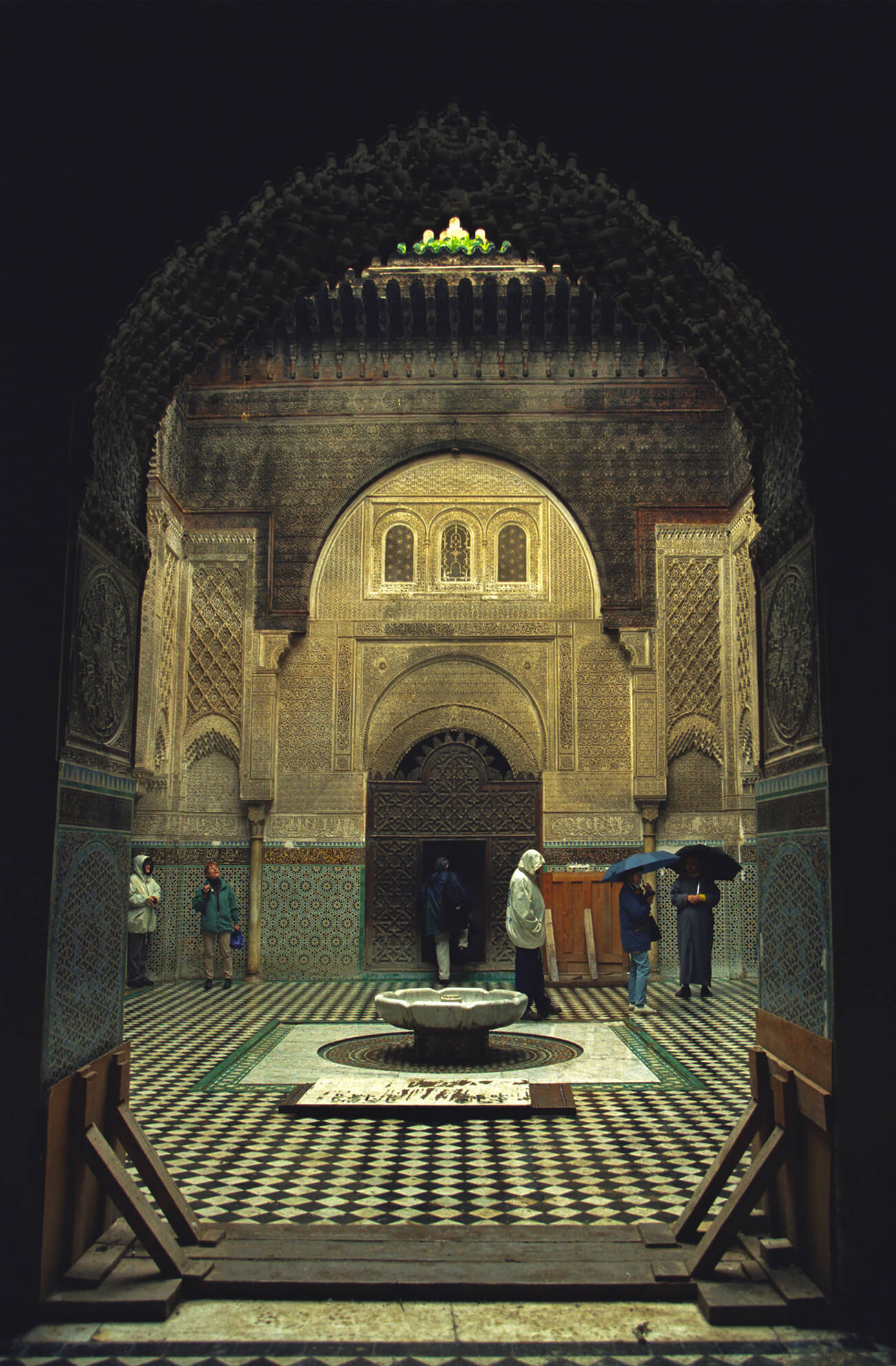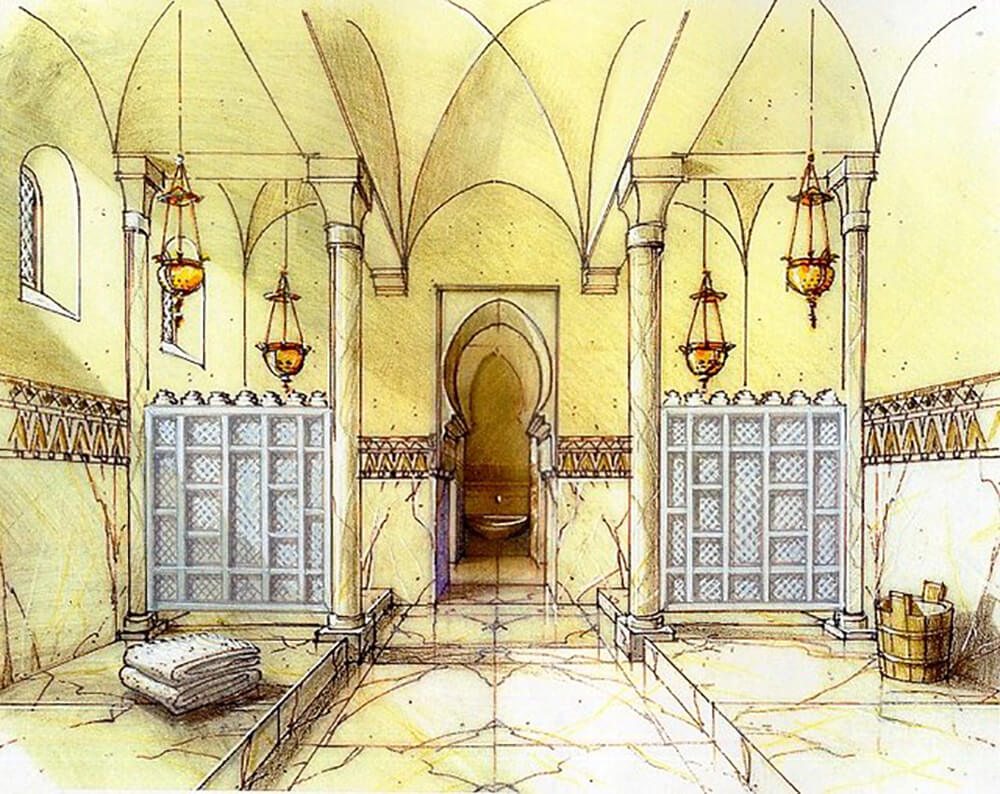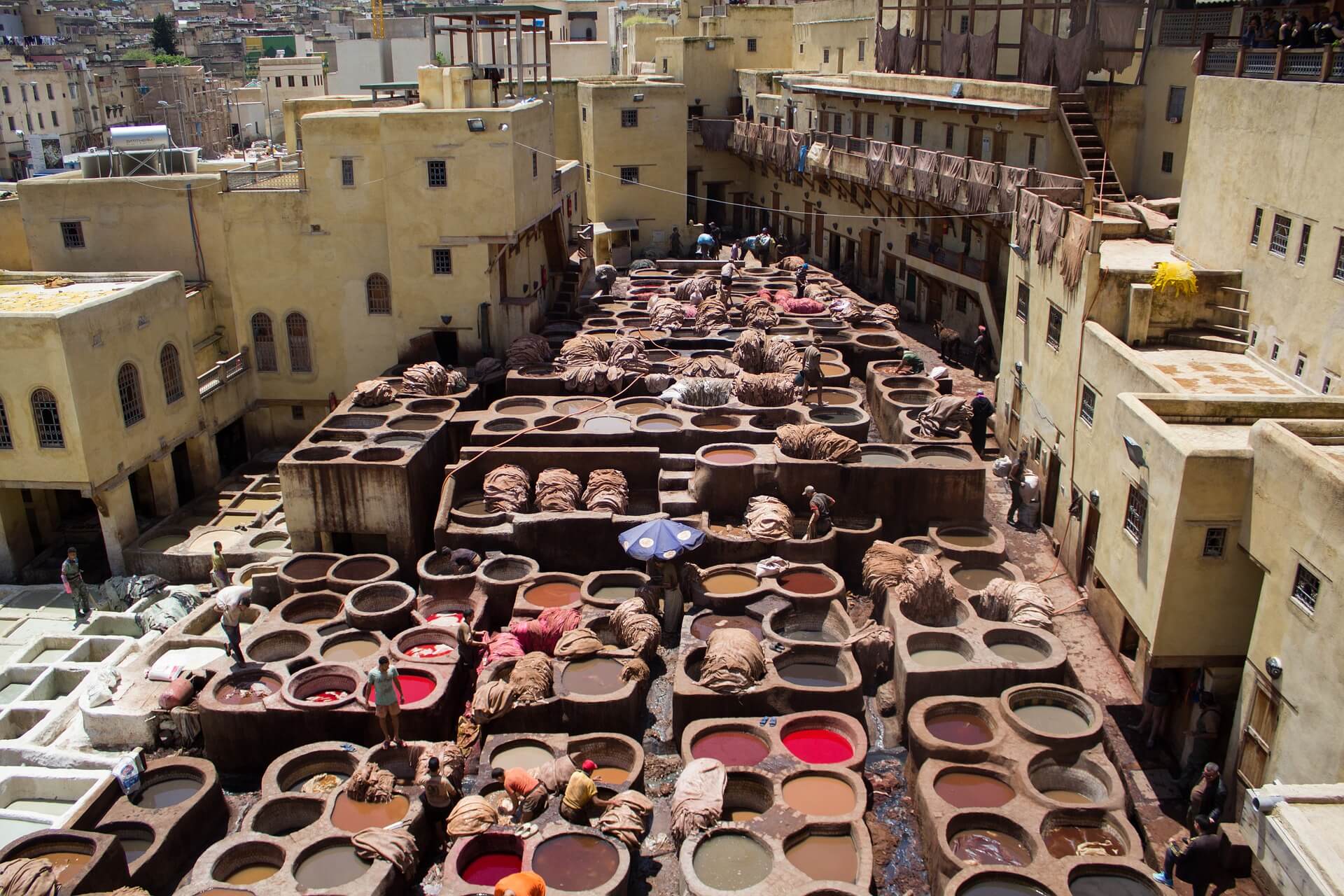Fez is Morocco’s spiritual, cultural, and historical capital that takes you back in time. Let yourself get lost in the world’s largest medina and enjoy multi-sensory experiences. With so many architectural treasures, this city is the best for sightseeing.
Fez is the second-largest city in Morocco and the oldest of the four imperial cities, a place where history lingers in every alleyway. Founded in the 8th century, it has long been regarded as the cultural, spiritual, and intellectual heart of the country. The city is famous for its handmade leather goods and the iconic Chouara Tannery, a place as photogenic as it is historic.
Fez is filled with exquisitely decorated medresas, beautifully carved fountains, and architectural masterpieces shaped by Islamic and Andalusian traditions. Everywhere you turn, the vibrant culture of Morocco reveals itself, making the city a destination that invites exploration at every turn.
Travelers often choose Fez as part of a wider journey through the country, and the city can easily be included in a Morocco package tour alongside Casablanca and Marrakech. Whether you come for the spiritual heritage, the craftsmanship, or the endless maze of its medina, Fez offers an atmosphere unlike anywhere else in Morocco.
Fez-el-Bali Medina
Entering the Fez-el-Bali Medina feels like stepping into a world that has barely changed for centuries. The ancient city walls create deep shadows over the narrow passages, and the maze of alleys twists so tightly that even experienced visitors find themselves wandering without a sense of direction.
Souks spill into the streets with spices, perfumes, leather goods, metal lamps, musical instruments, and trays of traditional sweets. Workshops hum with the sound of artisans shaping wood, working brass, weaving fabrics, and carving designs by hand. Everywhere you turn, you feel the presence of a culture that still values craftsmanship in its purest form.
It is also a wonderful place to learn more facts about Morocco culture as you watch artisans practice skills passed down through generations.
Despite the charm, the medina is not a place to rush through. Donkeys and mules still transport goods exactly as they did centuries ago, and it is common to step aside as they make their way through the crowd.
What you will not find are cars—this is the largest car-free urban area in the world. Some pathways are so tight that even two people can barely pass each other, adding to the sense of discovery and timelessness. Getting lost is part of the experience, and wandering freely is often the best way to uncover hidden courtyards, small family-run shops, and glimpses of everyday life.
Within the medina stand numerous historic mosques, as well as the University of al-Qarawiyyin, widely considered one of the oldest continuously operating universities in the world. The entire Fez Medina was recognized as a UNESCO World Heritage Site in 1981, a testament to the extraordinary cultural and architectural legacy that has been preserved here. Visiting this part of the city feels like walking through a living museum, one that continues to thrive as a vibrant community.

Chouara Tannery
The Chouara Tannery is one of the most iconic sights in Fez and a place where tradition unfolds in full color. Spread across a large open-air courtyard, the tannery is made up of stone vats filled with natural dyes and pungent soaking mixtures. The scene is striking: workers standing knee-deep in dye pits, animal skins draped over the edges of vats, and shades of red, yellow, and brown glowing under the sun.
The process has barely changed since medieval times, and watching it in action feels like witnessing a piece of living history. The smell, however, is unmistakable, so bringing a handful of fresh mint leaves to hold near your nose can make the experience far more pleasant.
From above, the tannery becomes even more spectacular. Many surrounding leather shops offer access to rooftop terraces, where you can look down over the mosaic of dye pits and observe the work from a distance. The views are exceptional, but it is customary to offer a small tip in exchange.
These shops also sell a wide range of handmade goods, from traditional babouches and slippers to handbags, jackets, and wallets. Prices vary, and haggling is expected, so take your time and enjoy the negotiation. Each piece carries the unique character of Fez’s craftsmanship, making it a meaningful souvenir of your visit.

Al Attarine Medresa
Al Attarine Medresa is one of the finest examples of Marinid architecture and a place where the artistic traditions of Fez reach extraordinary heights. Built in the early 14th century under the rule of Sultan Uthman II Abu Said, the medresa served as an important center for Islamic learning.
Stepping into its courtyard feels like walking into a perfectly balanced composition of design and craftsmanship. Marble pillars frame the space, while glazed zellige tiles form intricate geometric patterns that radiate across the walls in a harmony of shape and color.
Every detail invites admiration. Elaborate stuccowork weaves across archways and façades, while carved wooden elements soften the lines of the structure and add warmth to the space. Arabic calligraphy, painted with remarkable precision, curls across panels and beams in a way that feels both elegant and deeply spiritual.
The medresa’s beauty is so immersive that visitors often fall silent upon entering, taking time to absorb its calm and symmetry. Al Attarine is not merely an architectural landmark—it is a reminder of the refinement and artistic devotion that once defined scholarly life in Fez.

Ancient Roman Ruins of Volubilis
A short journey from Fez brings you to the ancient Roman city of Volubilis, a site that feels both monumental and hauntingly quiet. Set at the base of Jebel Zerhoun, the ruins stand in a wide, open landscape where the countryside stretches out in peaceful silence.
Long before the Romans arrived, the city was founded by the Amazigh, and it later became the capital of Mauretania before being absorbed into the Roman Empire. Walking through the site today offers an extraordinary glimpse into centuries of layered history.
Volubilis is considered the most well-preserved Roman archaeological site in Morocco, and much of its beauty lies in the mosaics scattered across former villas and public buildings. Many of these mosaics retain a surprising amount of vibrancy, still displaying scenes of mythology, nature, and daily life.
As you wander, you’ll also come across marble and bronze statues, carved columns, coins, and other artifacts that reveal the sophistication of this once thriving city. Although it is a popular destination, the vast, open setting often gives you moments of quiet solitude, making it easy to imagine how life once unfolded here.
Visiting Volubilis offers a chance to step into the past without crowds or noise, allowing the ancient world to speak for itself through art, architecture, and the enduring stillness of its surroundings.

Bab Bou Jeloud (Blue Gate)
This striking gateway marks one of the main entrances into the Fez medina and offers a memorable first glimpse of the city’s craftsmanship. The exterior is decorated with deep blue fassi tiles arranged in intricate geometric patterns, each one shaped and painted by hand.
Passing beneath the arch feels like slipping into another era, where the energy of the medina immediately surrounds you with the sounds of metalworkers, shopkeepers, and the steady movement of donkeys navigating the narrow streets.
A small but meaningful detail waits on the other side. When you step through the arch and turn back, the interior of the gate is green rather than blue—a symbolic nod to the color long associated with Islam. The contrast between the two sides adds a thoughtful touch to the structure and highlights the care put into its design.
Whether you arrive at dawn or during the lively rush of midday, the Blue Gate prepares you for the vibrant mix of history and daily life that defines Fez.

Marinid Tombs
High on a hill overlooking Fez stand the remnants of two mausoleums from the Marinid Dynasty, their weathered arches rising against the skyline. Very little is known about who was originally buried here, and time has stripped away many of the decorative details that once adorned the structures. What remains is a set of striking silhouettes and an atmosphere that feels both mysterious and serene.
Reaching the tombs is easy, whether by foot or by taxi, and the climb is well worth the effort. The elevated position offers one of the most impressive views of Fez, with the city unfolding below in a blend of rooftops, minarets, and winding streets. The countryside stretches farther in the distance, creating a panorama that feels especially magical at sunset.
As the light softens, the city shifts through warm shades of gold and rose, giving visitors a quiet moment to reflect on the history that shaped this ancient place.
Even though much of the original structure has faded, the Marinid Tombs remain a powerful reminder of Fez’s long and layered past. Their quiet presence on the hill invites you to slow down, take in the view, and connect with the city from a different perspective.

The Mellah (Jewish Quarter)
Fez’s Mellah is the oldest and most historically significant Jewish quarter in Morocco, a neighborhood that once served as a protected enclave for the city’s Jewish community. Walking through its streets offers a very different atmosphere from the medina.
The architecture shifts noticeably, with large wooden balconies, finely worked wrought-iron details, and façades that reflect a blend of Moroccan and Jewish heritage. The area carries a sense of quiet reflection, shaped by centuries of life, tradition, and eventual departure, as the community gradually relocated to other cities or moved abroad.
One of the most compelling places to visit here is the Jewish cemetery, a striking landscape of smooth, whitewashed tombs that seem to flow across the hillside. Its simplicity contrasts beautifully with the dense architecture of Fez, creating a powerful, contemplative space.
Nearby, the Danan Synagogue offers a deeper look into the community’s history. Inside, wooden doors and carved ceilings pair gracefully with traditional tiles and stucco, while original elements—such as oil lamps and wooden benches—have been carefully preserved. It is one of the few remaining synagogues in the country and stands as an important testament to Morocco’s Jewish heritage.
Exploring the Mellah reveals a lesser-known side of Fez, one rooted in resilience, faith, and cultural exchange. It is a place where the past feels close, inviting visitors to pause and appreciate a chapter of the city’s identity that continues to hold meaning even in its stillness.

Fez is far more than a destination; it is an experience that unfolds slowly, revealing its depth through every corner turned and every story embedded in its walls. The city invites you to wander without a plan, to pause for the unexpected, and to immerse yourself in traditions that have shaped Moroccan life for centuries.
With a blend of living history, rich culture, and timeless architecture, Fez offers a journey that resonates long after you leave. If you are seeking a place where the past feels vividly alive, this ancient city promises a connection you won’t soon forget.
🧭 FAQs
Q1: Is Fez worth visiting for first-time travelers to Morocco?
Yes. Fez offers one of the most immersive cultural experiences in the country, with a vast historic medina, traditional craftsmanship, and centuries of architectural and spiritual heritage woven into everyday life.
Q2: What is Fez best known for?
The city is famous for its medieval medina, the Chouara Tannery, and its role as Morocco’s cultural and spiritual capital. It is also home to the University of al-Qarawiyyin, considered one of the oldest continually operating universities in the world.
Q3: How many days do you need in Fez?
Most travelers find that two to three days allow enough time to explore the medina, visit the main landmarks, and take a day trip to nearby sites such as Volubilis. Staying longer gives you more space to enjoy the city at a relaxed pace.
Q4: Is it easy to get lost in the Fez medina?
Yes, and that is partly what makes it so memorable. The labyrinth of narrow alleys has very few straight paths, but getting lost is safe and often leads to interesting discoveries.
Q5: Is Fez safe for visitors?
Fez is generally safe for travelers, especially in popular areas of the medina. As in any busy city, staying aware of your surroundings and keeping valuables secure is wise, but most visitors feel comfortable exploring on foot.
Q6: What is the best time of year to visit Fez?
Spring and autumn are ideal, as the weather is mild and pleasant. These seasons make it easier to explore the medina, visit historical sites, and enjoy day trips without the intense summer heat.
Q7: Can you visit Fez on a day trip?
While a day trip is possible from nearby cities, it doesn’t allow enough time to appreciate the medina or visit major landmarks. Fez rewards slower exploration, so staying at least one night offers a far richer experience.








